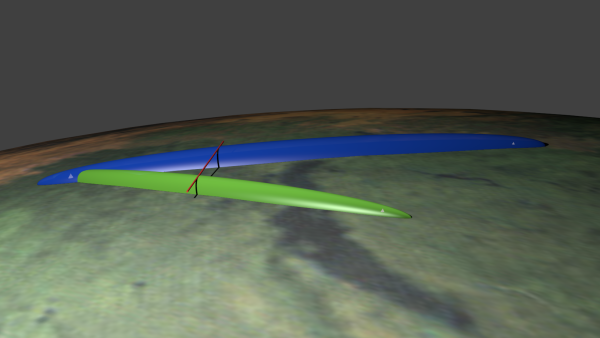Table of Contents
Methods of data processing used in Bolidozor network
This site contains several designs of algorithms used for data processing.
- Estimate of an vector of meteor in the atmosphere
- Record of available meteorological data for future reconstructions (satellite images, ČHMÚ measurements at a particular time, radar images)
- Data collections from individual stations
- Calculations of vector and vertical wind profile
There are some already existing projects that can used in the process of data processing.
Calculation of meteor trail parameters
There already exists a network dealing with similar problem called CMOR, which observes meteors using transmitter and several receiver stations. Such approach is, however, not really suitable for Bolidozor network.
The most realistic solution seems to be a calculations using spatial coordinates of meteor’s head-echo. This approach has already been tested Miguel A. Vallejo, EA4EOZ
Data from GRAVES radar
Meteor detection
Currently, meteors are detected by comparing the signal intensity in an area, where we expect the radio reflection, with the signal intensity in an area with frequency shift to the transmitted signal.
VOR transmitters
Aircraft navigation VOR transmitters are one of the options, how to see the radio reflections.
Signal model
To calculate the energy balance, Jakub Kákona has created a model of signal.
Collecting the data
When processing data from VOR beacons, it is necessary to solve a problem of lower radiated power of transmitter. Lower transmitter power causes that the intensity of received signals is often below the noise level.
- Signal detection above the noise level by at least one station
- Sending a control network packet with a request for data containing the suspicious part from the nearest stations. Possiblity of using ROS.
- Correlation of detected signal with noise on other stations.
- As a result of the calculation, the corresponding signal should be found in noise on other stations.
- A detection will be confirmed if the meteor will be detected on several stations at the same time.
- Otherwise, the event will be evaluated as a false detection.
In case of positive detection, model parameters to calculate the replica have to be extracted from the signal.
Calculation of path will be carried out using several methods. First is the multilateration based on different records’ time shifts on individual stations. Time shifts have to be obtained by time correlations of recorded data. This correlation can be carried out either in signal time-space or using Fourier transformations. In both cases, it is first necessary to isolate the useful signal of meteor in the noise.
Next step is a measurement of doppler parameters of meteor’s head-echo, which determines the inclination and speed of the path.
Overall, the path calculation implementation will be carried out in two steps:
- Calculation of meteor position with respect to individual stations (can be done using the reflection from meteor trail).
- Calculation of path vector in absolute coordinates.
Data from DVB-T
DVB-T signal has an advantage compared to VOR beacons in that it is broadband. This feature can help to improve the accuracy of measurement. However, the system transmits in multiplexes, meaning that there is a transmission of an identical signal from several places at once - causing a complication.
Decesion process and search for fragments
Should a scripting language be used to describe the ROS process?
- Command assignment to individual stations.
- Start re-planing due to unsuccessful launch or rejection from station.
- Control of a potential violation of airspace and prohibited zones.
Multichannel detector from GnuRadio
A Marcus Leech group, Science Radio Laboratories has prepared a signal schema for GnuRadio that enables a processing of more channels at once.
Optimising algorithms
Tools for algorithms testing
Interactive scientific tool Jupyter
A good solution for testing is an interactive iPython environment where you can directly try individual parts of code and process data.
Its basic installation in Ubuntu can be carried out by installing the following packages:
sudo apt-get install ipython-notebook python-scipy python-numpy
Afterwards, you can run iPython from the command line:
ipython notebook --pylab inline
In order to get acquainted with Python language you can use Codeacademy.
Existing iPython scripts
There are several already existing iPython notebooks for data processing from Bolidozor network - you can find them at: http://meteor1.astrozor.cz:8080/ More specifically for example Histogram of frequency shift of meteors and Visualisation of meteor trails from Meteor Observer Mobile aplication.
Scripts on server are reloaded every 5 minutes with runipy programme.

